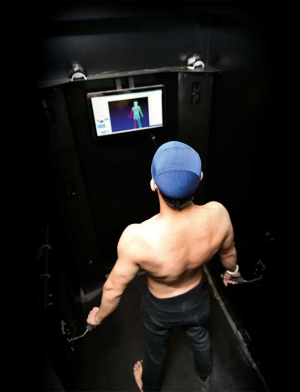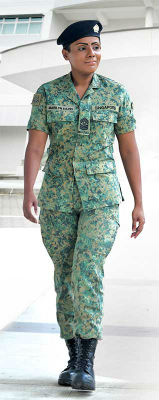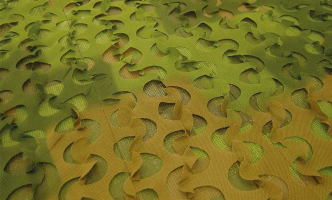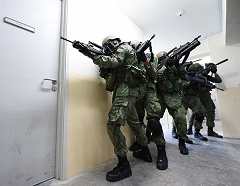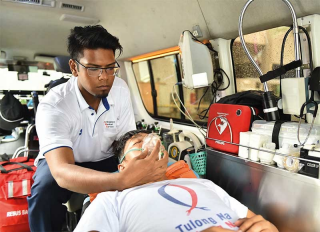With the use of 3D body and foot scanners for sizing, recruits can now look forward to receiving better-fitting uniforms and gear.
The first day of Basic Military Training (BMT) is usually a nerve-wracking and stressful affair for new recruits. The last thing they want is to be issued with No. 4 uniforms, boots and shoes that do not fit.
Such occurrences will now be minimised as the Singapore Armed Forces (SAF) has started using 3D body and foot scanners to obtain accurate measurements of each pre-enlistee's body and feet.
The 3D body scanner uses infrared rays to map a person's body in seconds, giving exact measurements of his or her head circumference, shoulder length, waistline and so on. Similarly, the digital foot scanner measures the size of both feet and determines the arch type.
With accurate measurements, the best ready-to-wear sizes of the uniform, jockey cap, helmet, physical training attire, combat boots and running shoes can be issued to the recruits. In addition, each recruit will receive running shoes best suited to his or her foot arch.
Getting the right fit is important as the combat effectiveness of a soldier is highly dependent on the reliability of his or her personal equipment. Hence, the SAF is continuously looking into ways to tap on technology to enhance its equipping process.
The e-sizing is part of a new initiative rolled out this year to provide better-fitting and improved personal equipment for its soldiers.
Using optical devices (above, left), the 3D scanner creates a digital body model (above, right) with exact measurements of the head circumference, shoulder length and waistline.
Hassle-free
Conducted at the Central Manpower Base (CMPB) after pre-enlistees undergo their medical check-up, the entire e-sizing process, including waiting time, takes only two to three minutes.
In the past, pre-enlistees had to take the measurements themselves at home using a measuring tape. To determine their foot arch, they had to wet their feet, walk on a piece of paper and examine the foot prints. They would then submit the measurements online through the NS Portal.
"As you can imagine, some of the pre-enlistees weren't confident about doing this. For example, which part of the waist do you measure exactly? Many didn't even have a measuring tape at home," said Ms Lim Seow Pheng, General Manager of Fulfillment Logistics, who was responsible for the procurement of the 3D body and foot scanners for Army Logistics Base (ALB). "As a result, some pre-enlistees submitted inaccurate measurements."
ALB is responsible for the issuing of personal equipment to new recruits. Early last year, Headquarters (HQ) Supply worked with CMPB and ALB to conduct a trial for 3D body and foot scanning solutions that best meet the needs of the SAF.
They invested in a foot scanner from a leading footwear and orthotics company, and a 3D body scanner from the world's first and largest manufacturer of 3D body scanners. When the 3D body scanner was introduced in 1999, the United States Navy was one of the first organisations in the world to use it.
A six-month trial conducted last August showed that the digital scanning helped to significantly reduce erroneous sizing of recruits' personal equipment.
REC Arjay trying out his No. 4 uniform on the first day of BMT.
Accurate sizing
Results from a six-month pilot trial which started in August last year showed that digital scanning helped to cut down erroneous sizing.
Of the 1,171 pre-enlistees enlisted in May this year who had undergone the scanning, only six percent required a change in uniform size during their enlistment. In the past, about 15 to 20 percent from each BMT intake had to take the time to do kit exchanges.
Said Ms Lim: "We can cut down on kit exchanges, minimise buffer stock requirement and streamline the entire process. This reduces any inconvenience caused and enhances the recruits' equipping experience when they enlist."
In the past, inaccurate manual measurements carried out at home was the main cause of recruits receiving uniforms and gear of the wrong size.
Ms Lim added that some recruits may also train intensively in the last few months before enlistment, losing much weight in the process. Thus, recruits may not always receive the personal equipment that best fits them.
"We aim to reduce the kit exchange to about two percent in the coming intakes," she said.
Among those who found their new uniforms well-fitting was Recruit (REC) Arjay Ravindran from Orion Company. As part of the trial, the 21-year-old did the manual measurements at home, as well as the e-sizing at CMPB.
Comparing both methods, REC Arjay said: "I didn't feel very confident about the manual measurement. What if I measured wrongly? With the 3D scanners, on the other hand I feel more assured because I know that whatever I am going to get will fit me properly.
"And I will feel more confident in training because I know that the shoes and boots are 'tailored' to my comfort."
With accurate readings from the foot scan, the appropriate size and type of running shoes can be issued to each recruit.
In the pipeline
Currently, the set of 3D body and foot scanners is able to conduct e-sizing for more than 150 recruits in a day. ALB will be obtaining an additional set of 3D body and foot scanners as a backup as well as to speed up the process.
To further cut down errors and improve efficiency, the use of robotic arms for packing is being explored. Since February this year, trials have been conducted to test the feasibility of using robotic arms to pick and pack personal equipment.
Currently, it takes nine staff to pack uniform and gear for about 200 to 300 recruits each day, which is a labour-intensive process. Through automation, this manual work could be reduced by 20 to 30 percent.
Chief Supply Officer Senior Lieutenant Colonel Terry Tan said: "HQ Supply is continuously exploring ways to improve the Army's combat effectiveness, and this e-sizing is the first part of the SAF's initiative to provide better-fitting and improved personal equipment our soldiers."
